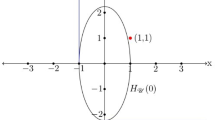Abstract
The concept of critical angle between two linear subspaces has applications in statistics, numerical linear algebra and other areas. Such concept has been abundantly studied in the literature. Part I of this work is an attempt to build up a theory of critical angles for a pair of closed convex cones. The need of such theory is motivated, among other reasons, by some specific problems arising in regression analysis of cone-constrained data, see Tenenhaus in (Psychometrika 53:503–524, 1988). Angle maximization and/or angle minimization problems involving a pair of convex cones are at the core of our discussion. Such optimization problems are nonconvex in general and their numerical resolution offers a number of challenges. Part II of this work focusses on the practical computation of the maximal angle between specially structured cones.
Similar content being viewed by others
References
De Cock K, De Moor B (2002) Subspace angles between ARMA models. Syst Control Lett 46:265–270
De Cock K, De Moor B (2000) Subspace angles between linear stochastic models. In: Proceedings 39th IEEE conference on decision and control, Sydney, Australia
Fiedler M, Haynsworth E (1973) Cones which are topheavy with respect to a norm. Linear Multilinear Algebra 1:203–211
Goldberg F, Shaked-Monderer N (2014) On the maximal angle between copositive matrices. Elec J Linear Algebra 27:837–850
Hotelling H (1936) Relations between two sets of variates. Biometrika 28:321–377
Iusem A, Seeger A (2007) Angular analysis of two classes of non-polyhedral convex cones: the point of view of optimization theory. Comput Applied Math 26:191–214
Jordan C (1875) Essai sur la géométrie à \(n\) dimensions. Bull Soc Math France 3:103–174
Lyubich Y (1995) Perron-Frobenius theory for finite-dimensional spaces with a hyperbolic cone. Linear Algebra Appl 220:283–309
Mohammadi B (2014) Principal angles between subspaces and reduced order modelling accuracy in optimization. Struct Multidiscip Optim 50:237–252
Obert DG (1991) The angle between two cones. Linear Algebra Appl 144:63–70
Seeger A (1999) Eigenvalue analysis of equilibrium processes defined by linear complementarity conditions. Linear Algebra Appl 292:1–14
Seeger A (2011) Epigraphical cones I. J Convex Anal 18:1171–1196
Seeger A, Sossa D (2015) Critical angles bewteen two convex cones. Part I: general theory. TOP, online since. doi:10.1007/s11750-015-0375-y
Shashua A, Wolf L (2003) Learning over sets using kernel principal angles. J Mach Learn Res 4:913–931
Tenenhaus M (1988) Canonical analysis of two convex polyhedral cones and applications. Psychometrika 53:503–524
Author information
Authors and Affiliations
Corresponding author
Additional information
D. Sossa is supported by CONICYT, Chile.
Rights and permissions
About this article
Cite this article
Seeger, A., Sossa, D. Critical angles between two convex cones II. Special cases. TOP 24, 66–87 (2016). https://doi.org/10.1007/s11750-015-0382-z
Received:
Accepted:
Published:
Issue Date:
DOI: https://doi.org/10.1007/s11750-015-0382-z
Keywords
- Nonconvex optimization
- Maximal angle
- Critical angle
- Convex cones
- Topheavy cones
- Ellipsoidal cones
- Cones of matrices




